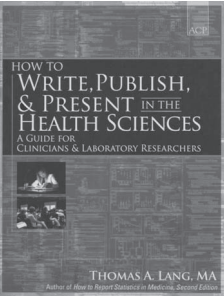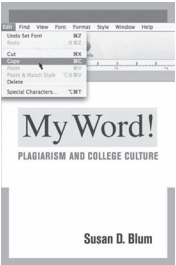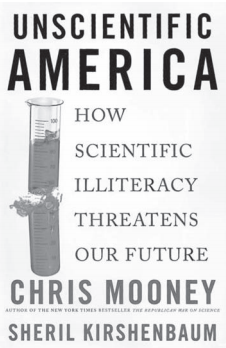
Thomas A Lang’s new book, How to Write, Publish, & Present in the Health Sciences: A Guide for Clinicians & Laboratory Researchers, although not flawless, is a great guide.
Why I loved this book . . .
So incredible that I wish it was edible. I feasted on this book (and judging by the drool marks that stain the back matter, apparently so did my 1-year-old). Lang practices what he preaches: his text is clear, concise, and engaging. I especially like how Lang infuses his prose with an understated sense of humor. The book is a paradigm of organization, and the formatting is sublime. Finally, although the prospect of writing a book of such broad scope would frustrate most medical writers, Lang adeptly touches on many important facets of the field: abstracts, proposals, poster presentations, slide presentations, article writing, and more. Sometimes I (almost) forgot that I was reading a guide on healthscience communication and sailed through pages as though I were navigating a John Grisham novel.
The divinity is in the details. Lang does a great job of mixing up the menu and serving up concepts not commonly featured in such fare. He addresses issues that I’ve wondered about and hoped to find good answers to, including the origins of biomedical writing, the pros and cons of book authorship, and “objective” reputation measures of various medical journals (impact factor, PageRank, and more). Reading his book was like climbing into the front seat of your new car and being pleasantly surprised by all the cool little amenities.
Why I merely liked this book . . .
Them’s some pretty strong words, pardner. I’m mentored by one of Lang’s contemporaries, and I’m used to implied meaning. When my adviser says, “You may want to consider”, I perk up my ears—I’m receiving (really good) advice. Lang breaks from convention and is refreshingly direct. He doesn’t mince words; he speaks with conviction. In a field rife with shades of gray, Lang doesn’t hesitate to point out the contrast. For example, he makes it clear that ghost authoring is bad, authors should have read all cited sources in their entirety, and image enhancements should be explained in accompanying captions. Because I was once a medical student and resident, I’ve grown to appreciate rules. Sometimes it’s easier to let somebody else take the lead and show me, especially when they know more.
Majestic aesthetics. With respect to medical writing, visual media are arguably just as important as accompanying text. But few texts explain how to manage diagnostic images, tables, charts, and graphs effectively. We live in an age of rapidly advancing technology, which makes such instruction imperative—Lang realizes this.
Suggestions for the next edition
Garnish the margins—more asides, please! Lang’s text is accessorized by amusing and insightful quotations set off in the margins. He quotes diverse luminaries—both specialist and nonspecialist—including Morris Fishbein, Isaac Asimov, and Franklin Delano Roosevelt. But sadly, not every page is adorned with these little gems, and this leaves much white space. Maybe Lang could find additional quotations or tastefully fill the margins with other interesting tidbits. For example, Lang mentions the Ingelfinger–Relman rule but doesn’t talk about embargoes—a topic that fascinates many medical writers and editors. Maybe he could devote some margin space to explaining embargoes.
Show us more style! Before I formally studied science writing and editing, I didn’t know that written style existed. (To me, style meant red carpets and catwalks.) Works like Fowler’s, Strunk and White, and the AMA Manual of Style were unknown to me. I had no idea that writing was principled (and judging by the sheer volume of physician-written work that I edit, I wasn’t alone). Physicians are suckers for rules and algorithms, and I imagine that many of them would be excited to learn that there is a quasiobjective set of rules that shepherd fine writing. Lang devotes some text to style and serves up a few morsels, but there’s more. (Personally, I’m a sucker for word choice—that versus which, if versus whether, fewer versus less—and I was disappointed that the text didn’t delve into the topic. I would have loved to read Lang’s take on the subject.) I recommend that those interested in learning more about style search the Internet for the very good (and very free) Editing and Publication: A Training Manual by Ian Montagnes.
After reading How to Write, Publish, & Present in the Health Sciences, I feel privileged to take instruction from Lang, a modern pillar in the field. Furthermore, I feel that, in many ways, I witnessed the world of medical writing and editing from his perspective. Advice that would have taken me a lifetime to learn was explained to me in a few crisp sentences. Ultimately, this book’s audience is not only clinicians and researchers but all students of medical writing. I could easily see this book repackaged as a textbook replete with key words, questions, and summaries. Until then, I plan to recommend that all my fellow science and technology journalism graduate students purchase a copy to use as an essential reference. (I keep my copy on my bookshelf next to a copy of Lang’s other weighty work, How to Report Statistics in Medicine: Annotated Guidelines for Authors, Editors, and Reviewers.)
NAVEED SALEH is a physician–journalist, freelance editor, and science-journalism graduate student at Texas A&M University.
Book Notes

CULTURE. SUSAN D BLUM. ITHACA,
NY: CORNELL UNIVERSITY PRESS; 2009.
240 PAGES. HARDCOVER $24.95. ISBN-13:
978-0-8014-4763-1.
My Word! focuses on why students plagiarize, but in so doing, it is a much broader commentary. Author Susan D Blum—an anthropology professor at the University of Notre Dame—explains that the book is an ethnographic study of “traditional, selective residential colleges”. It explores student values and behavior, including other forms of theft and cheating, such as illegally downloading music and cheating on a test.
Blum does not pass judgment on plagiarism but instead explains her ideas, based on interviews of students, about why it is so common. She argues that in a world where Wikipedia is often the first Google search result, notions of authorship have become blurred, and sharing is seen as “one of the primary virtues”. Furthermore, she says, students today care more about their “performance selves”—the image that they project to the world—than about the authenticity that was important to the previous generation.
As a recent graduate of a residential college, I found most of her conclusions accurate. Especially at small residential colleges, academic life and social life are geographically and culturally indistinguishable. As Blum points out, quotations enjoy a prominent place on Facebook profiles, as the text of Instant Messenger “away” messages, and in casual conversation; it can be difficult to remember to cite when quoting in academic contexts.
My Word! is a quick, entertaining read and would be especially useful for those who work in a university or college or otherwise have frequent contact with undergraduates. It will also help writers and editors to clarify their views on plagiarism in a postmodern world and communicate those views to the next generation of scholars.
CHRISTINA SUMNERS is a science-journalism graduate student at Texas A&M University. She prepared this review while a Science Editor intern.

CHRIS MOONEY, SHERIL KIRSHENBAUM. NEW YORK, NY: BASIC BOOKS; 2010. 240 PAGES. $15.00. ISBN-13: 978-0-4650-
1917-5.
Science Editor has published many articles on improving scientists’ communication skills. Authors Mooney and Kirshenbaum provide a different perspective in Unscientific America—the audience’s capacity for understanding science. At the end of World War II and during the Cold War and Space Age, Americans looked to scientists for leadership in technology and research. Now, when only science can answer the most pressing global challenges, our nation verges on scientific illiteracy, and distrust of scientists is not uncommon.
Cultural changes in America since the middle 1940s have resulted in a sharp divergence between science and society. Science news sources once relied on by the public and the depth and amount of science coverage by the mass media have been drastically reduced. Newspapers and other media outlets have been consolidated into huge conglomerates, and many of their science reporters have been laid off. What the news media regard as “newsworthy”—flashy bold headlines of major new discoveries—is generally in conflict with the slow, methodical scientific research that usually results in incremental increases in knowledge. Mooney and Kirshenbaum devote chapters to the rifts between science and politics and religion and to how Hollywood movies and Internet bloggers have altered the public perception of science and scientists.
This look back is essential for understanding the current crisis in scientific communication. To improve communication, we must understand the interplay of culture, politics, religion, economics, and technology in modern America’s perception and understanding of science. This book is a good place to start.
SUSAN MSHIRLEY is a freelance science editor in Corpus Christi, Texas.
